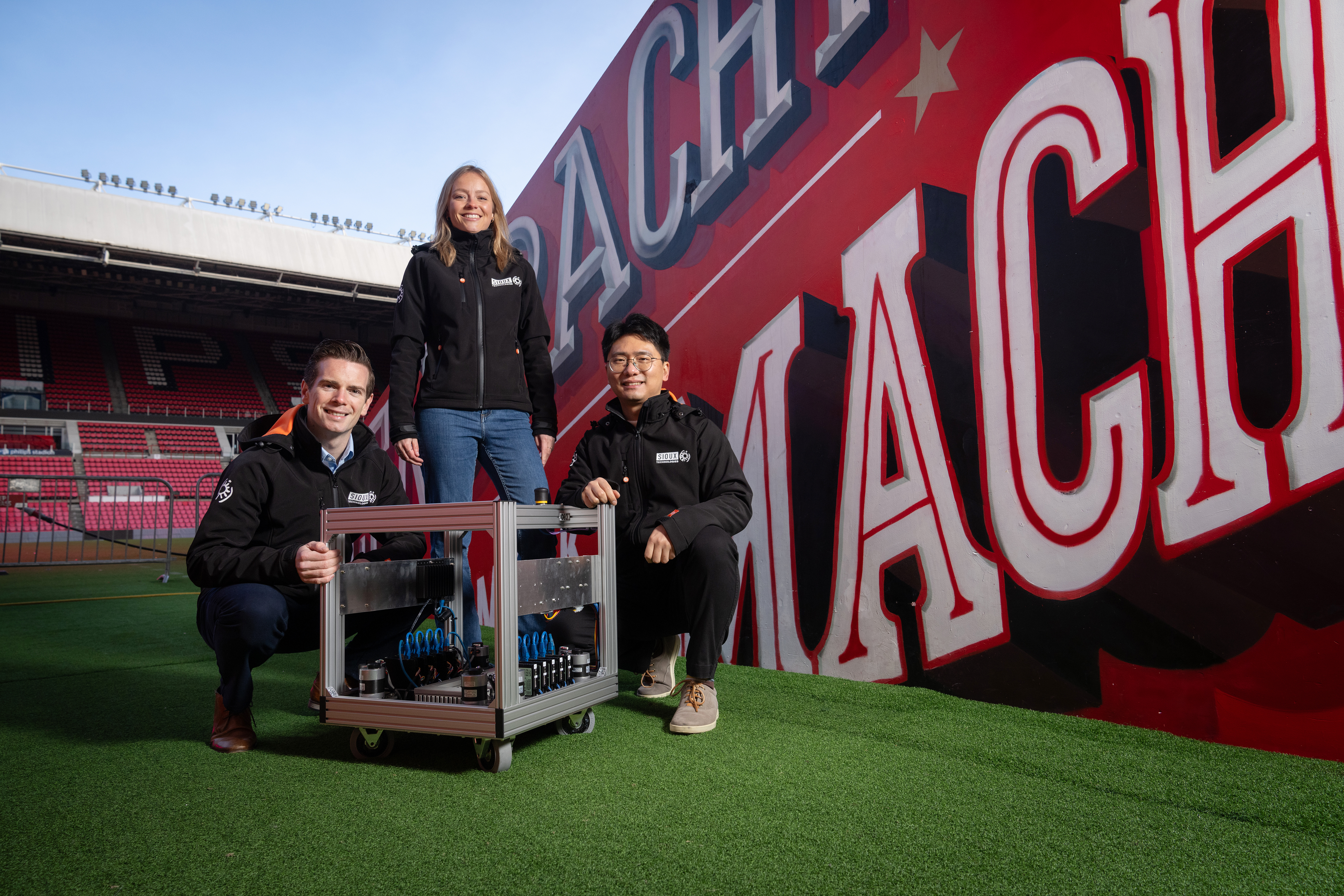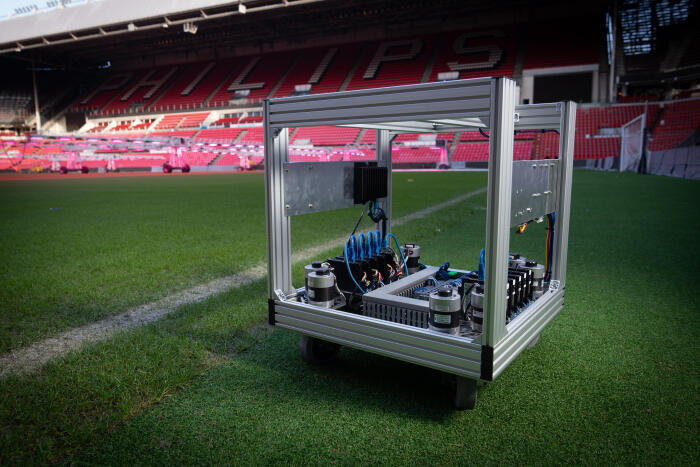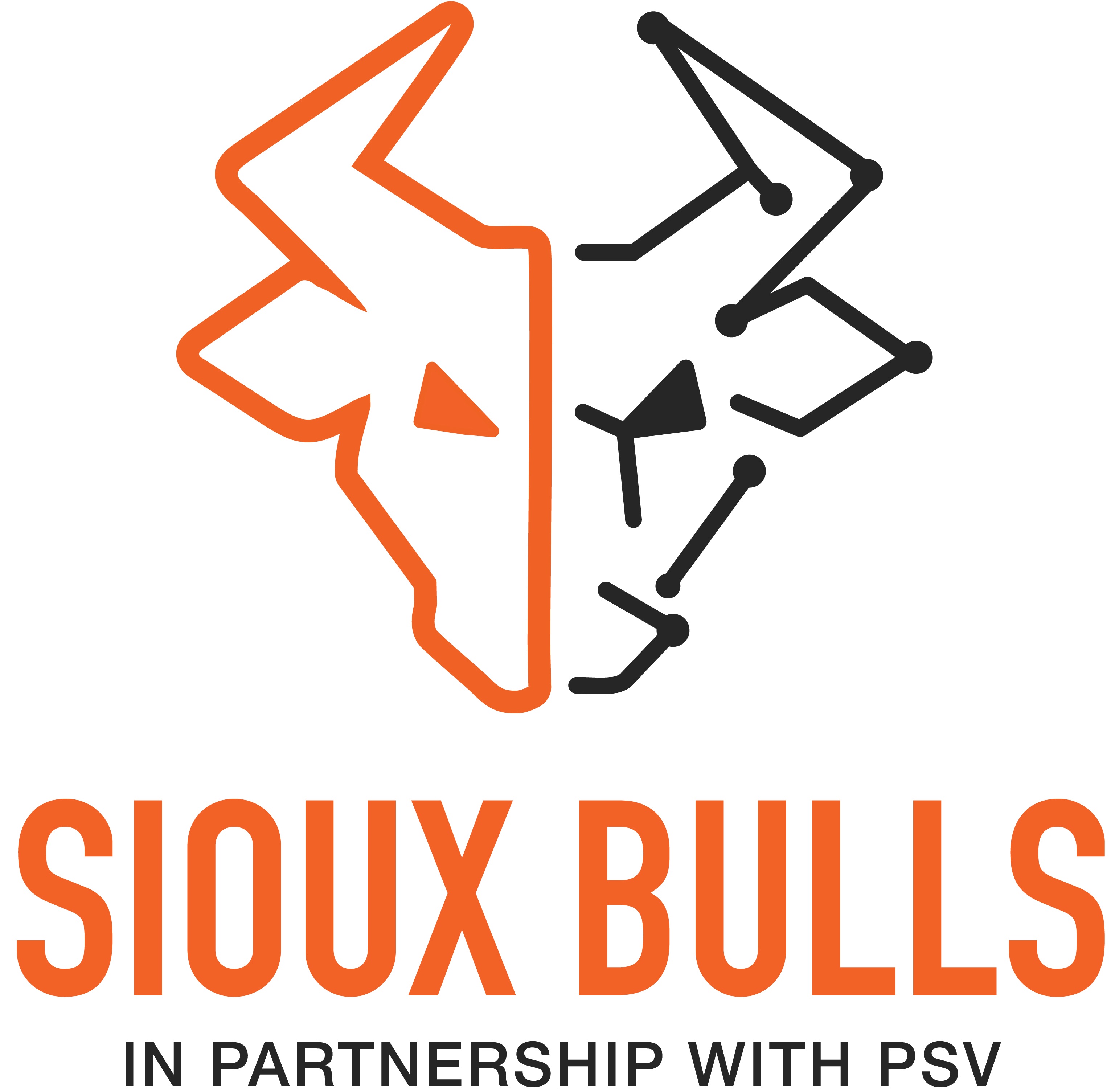PSV and Sioux want to surprise the world at RoboCup: 'Playing soccer with groundbreaking technologies'
 From left to right: Kevin ten Braak, Maxime Boesten and Xi Luo
From left to right: Kevin ten Braak, Maxime Boesten and Xi Luo
Source: PSV Business Magazine 2025 (in Dutch) >>
PSV and its partner Sioux Technologies have an ambitious plan. By combining their knowledge, they want to become a top player in the RoboCup, a global championship for soccer playing robots, in two years. “We are confident that we are going to surprise the world,” assures team leader Xi Luo.
The RoboCup has been around since 1997 and over the years has been organized in cities around the world; from Mexico City and Singapore to Istanbul and, of course, Eindhoven. The goal: to promote technological developments in robotics and artificial intelligence in a way that appeals to a broad group of people. So far, this has been an excellent success. To get an impression: at last year's edition in Eindhoven alone, 2,000 participants and 50,000 visitors were present. The global battle at the intersection of high-tech and sports has become a success.
PSV and Sioux want to participate in the RoboCup in the most challenging category: the Middle Size League. In this, two teams of five fully autonomous robots on wheels play against each other, with an official FIFA soccer ball. All this on a 14-by-22-meter indoor soccer field, surrounded by stands of spectators. “Each robot has sensors and a computer with which it analyzes the game situation,” says Xi Luo at Sioux Technologies' headquarters in Eindhoven. “Through wireless communication, the robots communicate with each other. People are not allowed to interfere in the game, except to take robots in and out of the field.”
The robots may weigh up to forty kilograms and each duel consists of two 15-minute games. “There is also a human referee, who communicates to the robots via computer and a wireless network when a free kick or yellow card is given, for example. It's worth watching a match.”
LABORATORY FOR THE LATEST TECHNOLOGIES
The RoboCup is much more than a sporting competition. It is a laboratory of sorts for the latest technologies in robotics, artificial intelligence (AI) and machine learning. The competitions give scientists, engineers and technicians a chance to see their prototypes in action, often resulting in significant breakthroughs beyond soccer. The innovation fostered in the RoboCup not infrequently has far-reaching implications for other industries, such as healthcare, transportation and aerospace. For example, robots in the competition are trained to respond to unpredictable conditions, which also makes them suitable for applications in high-risk or hazardous environments.
“All in all, the RoboCup promotes the development of technologies that can change the world; from autonomous driving to medical robots that help people,” Luo knows. “The idea is to present technology in a way that is both technical and accessible to a wide audience. This is what makes the RoboCup so interesting: it is fusion of sports, technology and science.”
ANALYTICAL INDUSTRY
Sioux Technologies, which has more than a thousand employees, sees the RoboCup as a wonderful way to show the world what it has to offer. “At events we host, you see the fascination among adults and children alike with the cutting-edge technology we are involved with,” says Luo. “That's wonderful. Every engineer wants to create something beautiful and show it to the world. For us, however, that's not always easy. Much of what we do, for example for the analytical industry, remains intangible to the general public. By participating in the RoboCup, we can share our passion for innovation and groundbreaking technology. And show what extraordinary things we are capable of as a company. Sioux brings high-tech to life and we want to demonstrate this in optima forma.”
Kevin ten Braak, sales and account manager at Sioux, concurs: “Apart from that, it also gives our engineers noticeable fun. And that is one of our company's core values: fun on the shop floor. Several great things come together in this project.”
Sioux Technologies was founded in 1996 as a privately held high-tech company with high ambitions. The Eindhoven-based multinational describes itself as a partner that develops, innovates and assembles complex high-tech systems with advanced software, mathware, electronics and mechatronics. Sioux has thirteen offices spread across Europe and Asia. Its annual turnover is about 150 million euros.
In recent years, artificial intelligence - also known as AI - is a concept that more and more people are encountering. And the next technological revolution is already in the making: Embodied AI. This involves combining artificial intelligence with a physical body in the form of a robot. That changes enormously the way robots are developed. It means that robots will not only use intelligent software to learn, but will also become physical objects that can move, feel and react to their environment. This makes them much more suitable for use in the real world, where physical interaction and decision-making are essential.
Luo: “This also creates opportunities regarding the skill and performance of soccer robots. This is therefore a perfect time for Sioux to enter the competition and make rapid progress. Building soccer robots and making them function as a successful autonomous team is a challenge of stature.”
Sioux is currently working with several dozen people on Project Robo. “As a new team, we started with a blank canvas,” Luo knows. “You really have to build the robot step by step. First they have to be able to see, know where they are, learn to run, talk to each other, and there are countless other basic functionalities. Eventually you get to issues like: how can you get the robot to head as well as possible and perform other useful tricks? Fortunately, we have many departments at Sioux with an enormous amount of knowledge. We are bringing that together in this project.”
Applying advanced technologies such as machine learning and digital twinning - creating digital replicas of the robots in a virtual world for testing and improvement - helps the team significantly. Says Luo, “By virtually testing and optimizing the robots in a digital environment, we can learn faster from their performance and train them more efficiently for the real competitions.”
For those in the know, he mentions some technical examples. “We are going to bring together a lot of state-of-the-art technology in the form of: high-precision motion control, optimization, model-based software design, machine learning, digital twinning and edge computing, among others. Our advantage: we have a lot of knowledge in all those areas and can build on a lot of experience in applying them. That's what sets us apart from the rest.”
Moreover, they are the only RoboCup team that has joined forces with a professional soccer club: PSV. “That sporting partnership came about in a fairly fortuitous way,” recalls Ten Braak. “We were in talks with PSV about a sponsorship contract at the time we were also working on our RoboCup plans. At one point we said to each other: how nice would it be to make it more than just a sponsorship contract and to ensure a cooperation with the greatest possible impact? In the end, we then set the goal to participate in the RoboCup for the first time next summer and to hopefully be able to show very nice things within a few years.”
The plan is to learn from each other. Ten Braak: “PSV, for example, can learn a lot from us in the field of AI. On the other hand, we use PSV's statistics and advanced data analysis. With this we hope to get answers to: how do you formulate the best tactics and how do we maximize the chances of winning?”
The partnership with PSV also gives Sioux the opportunity to apply the technology in the real world. Indeed, PSV has vast amounts of data on the performance of its players, something Sioux can thus make use of. By applying machine learning to this data, Sioux's robots can develop more soccer intelligence, such as analyzing the game, recognizing strategic moments and making the right decisions. This is exactly the challenge of robot soccer: robots must not only be physically capable of playing, but also be able to think tactically and react to the dynamic game situation.
Robot soccer in the RoboCup thus not only offers a fun and technical challenge, but also plays a role in developing the technologies that can improve the world in many ways. “The robots competing on an indoor soccer field today can tomorrow lay the foundation for the autonomous systems that will support our cities, our medical care and our economies of the future,” describes Ten Braak. “It doesn't get much better than that, does it?”
Will the PSV logo soon appear on the robots at the RoboCup? “We will definitely try that,” Luo concludes with a smile. “That would complete the picture.”

SEPERATE STORY
There are also a lot of people who criticize robots. What if they eventually become strong enough to attack humans, for example? “I understand the question,” acknowledges Xi Luo, System Designer Mechatronics at Sioux Technologies. “But that's really not on the horizon in the near future, and it's a responsibility of all of us to continue to deal with it ethically even at a later stage. I'm positive about that.”
Luo also says it will be some time before robots are able to beat today's top footballers on the field. “The robots on wheels can already beat people up to 10 years old. And within five to 10 years, we will probably see some demonstration matches of humans against robots that actually look like humans. But that they can beat top human soccer players is still a long way off.”
